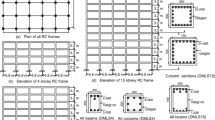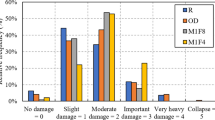Abstract
Following several damaging earthquakes in China, research has been devoted to find the causes of the collapse of reinforced concrete (RC) building sand studying the vulnerability of existing buildings. The Chinese Code for Seismic Design of Buildings (CCSDB) has evolved over time, however, there is still reported earthquake induced damage of newly designed RC buildings. Thus, to investigate modern Chinese seismic design code, three low-, mid- and high-rise RC frames were designed according to the 2010 CCSDB and the corresponding vulnerability curves were derived by computing a probabilistic seismic demand model (PSDM).The PSDM was computed by carrying out nonlinear time history analysis using thirty ground motions obtained from the Pacific Earthquake Engineering Research Center. Finally, the PSDM was used to generate fragility curves for immediate occupancy, significant damage, and collapse prevention damage levels. Results of the vulnerability assessment indicate that the seismic demands on the three different frames designed according to the 2010 CCSDB meet the seismic requirements and are almost in the same safety level.
Similar content being viewed by others
References
Abrahamson NA (1992), “Non-stationary Spectral Matching,” Seismological Research Letters, 63(1): 30–30.
ATC (1985), Earthquake Damage Evaluation Data for California, ATC-13 Report, Applied Technology Council, Redwood City, California.
Casciati F and Faravelli L (1991), Fragility Analysis of Complex Structural Systems, Somerset, UK: Research Studies Press, Wiley, 1991.
Celik OC and Ellingwood BR (2009), “Seismic Risk Assessment of Gravity Load Designed Reinforced Concrete Frames Subjected to Mid-america Ground Motions,” ASCE Journal of Structural Engineering, 135(4): 414–424.
Celik OC and Ellingwood BR (2010), “Seismic Fragilities for Non Fuctile Teinforced Voncrete Grames Role of Aleatoric and Epistemic Uncertainties,” Structural Safety, 32(1): 112.
Chen GX (2003), “The Evolution and Prospect of the Code for Seismic Design of Buildings in China,” Journal of Disaster Prevent and Mitigation Engineering, 23(1): 102–113.
Cornell AC, Jalayer F and Hamburger RO (2002), “Probabilistic Basis for 2000 SAC Federal Emergency Management Agency Steel Moment Frame Guidelines,” Journal of Structural Engineering, 128(4): 526–532.
CSI.SAP2000 Version 14. (2009), Integrated Finite Element Analysis and Design of Structures Basic Analysis Reference Manual, Berkeley, California (USA), Computers and Structures Inc.
Deng HS (2010), “Research on Building Structure Seismic Fragility Assessment Method,” China Water Transport, 10(5): 140–141. (in Chinese)
Ellingwood BR (2001), “Earthquake Risk Assessment of Building Structures,” Reliability Engineering and System Safety, 74: 251–262.
Ellingwood BR, Celik OC and Kinali K (2007), “Fragility Assessment of Building Structural Systems in Mid America,” Earthquake Engineering and Structural Dynamics, 36(13): 1935–1952.
Elnashai AS and Izzuddin BA (1993), “Modelling of Material Non-linearities in Steel Structures Subjected Totransient Dynamic Loading,” Earthquake Engineering and Structural Dynamics, 22(6): 509–32.
FEMA (Federal Emergency Management Agency) (2000), Prestandard and Commentary for the Seismic Rehabilitation of Buildings, FEMA 356. Washington, D.C.
Guo JW and Guo Y (2003), Seismic Design of Building. Tsinghua Publishing House, Beijing, China. (in Chinese).
Hancock J, Watson-Lamprey J, Abrahamson NA, Bommer JJ, Markatis A, McCoy E and Mendis R (2006). “An Improved Method of Matching Response Spectra of Recorded Earthquake Ground Motion Using Wavelets,” Journal of Earthquake Engineering, 10(1): 67–89.
Huang R and Li WL (2008), “Reserch on Development and Distribution Rules of Geohazards Induced by Wenchuan Earthqauke on 12th May, 2008,” Chinese Journal of Rock Mechanics and Engineering, 27(12): 2585–2592. (in Chinese)
Hwang H and Liu JB (2004), “Seismic Fragility Analysis of Reinforced Concrete Bridges,” China Civil Engineering Journal, 37(6): 47–51. (in Chinese)
Lu DG, Yu XH, Pan F and Wang GY (2010), “Probabilistic Seismic Demand Analysis of Structures Based on an Improved Cloud Method,” Would Earthquake Engineering, 26(1): 8–15. (in Chinese)
Ma CQ (1995). “Investigation of Seismic Disasters of Tangshan Earthquake,” Recent Developments in World Seismology, 8(1): 24–25. (in Chinese).
National Standard of the People’s Republic of China (NSPRC) (1979), Chinese Aseismic Code of Industrial and Civil Building (TJ11-78), Ministry of Construction of Peoples Republic of China, Beijing, China (in Chinese).
National Standard of the People’s Republic of China (NSPRC) (1989), Chinese Code for Seismic Design of Buildings (GBJ11-89), Ministry of Construction of Peoples Republic of China, Beijing: China. (in Chinese).
National Standard of the People’s Republic of China (NSPRC) (2001), Chinese Code for Seismic Design of Buildings (GB50011-2001), Ministry of Construction of Peoples Republic of China, Beijing, China. (in Chinese)
National Standard of the People’s Republic of China (NSPRC) (2002), Chinese Concrete Structure Design Code (GB 50010-2002), Ministry of Construction of Peoples Republic of China, Beijing, China. (in Chinese)
National Standard of the People’s Republic of China (NSPRC) (2006), Chinese Load Code for the Design of Building Structures (GB 50009-2001), Ministry of Construction of Peoples Republic of China, Beijing, China. (in Chinese)
National Standard of the People’s Republic of China (NSPRC) (2010), Chinese Code for Seismic Design of Buildings (GB50011-2010), Ministry of Construction of Peoples Republic of China, Beijing, China. (in Chinese)
Rossetto T and Elnashai A (2003), “Derivation of Vulnerability Functions for European-type RC Structures Based on Observational Data,” Engineering Structures, 25(10): 1241–1263.
Rossetto T and Elnashai A (2005), “A New Analytical Procedure for the Derivation of Displacement-based Vulnerability Curves for Populations of RC Structures,” Engineering Structures, 27(3): 397–409.
Shinozuka M, Feng Q, Lee J and Naganuma T (2000), “Statistical Analysis of Fragility Curves,” ASCE Journal of Engineering Mechanics, 126(12): 1224–1231.
Singhal A and Kiremidjian AS (1996), “Method for Probabilistic Evaluation of Seismic Structural Damage,” ASCE Journal of StructuralEngineering, 122(12): 1459–1467.
Tang J (2008), The Direct Economic Property Losses in Wenchuan Earthquake Were 845.1 billion Yuan (RMB), and It Caused 87 Thousand Casualties in China, CCTV Corporation. http://news.cctv.com/china/20080904/102837.shtml. (in Chinese)
Tsai KC, Hsiao CP and Bruneau M (2000), “Overview of Building Damages in 921 Chi-Chi Earthquake,” Earthquake Engineering and Engineering Seismology, 2(1): 93–108.
Tsai YB and Huang MW (2000), “Strong Ground Motion Characteristics of the Chi-Chi, Taiwan Earthquake of September 21, 1999,” Earthquake Engineering and Engineering Seismology, 2(1): 1–21.
Wang X, Masaki K and Irikura K (2011), “Building Damage Criteria from Strong Ground Motion Characteristics During the 2008 Wenchuan Earthquake,” Journal of Earthquake Engineering, 15: 1117–1137.
Wu D, Xiong Y and Tan P (2010), “Research on the Application of Information System to Damage of Buildings in Wenchuan County Town During the Wenchuan Earthquake,” ICIME 2010, 2010 the 2nd IEEE International Conference on Information Management and Engineering (IEEE), Chengdu, China.
Xu GD, Yuan Y, Fang WH and Shi P (2011), “Fast Loss Assessment of Mw7.1 Yushu Earthquake,” Journal of Earthquake Engineering and Engineering Vibration, 31(2): 114–123. (in Chinese)
Yin ZQ, Zhao Z and Yang SW (2003), “Relation Between Vulnerability of Buildings and Earthquake Acceleration Spectra,” Journal of Earthquake Engineering and Engineering Vibration, 23(4): 195–200. (in Chinese)
Zhang JH and Hu SD (2005) “State of the Art of Bridge Seismic Vulnerability Analysis Research,” Structural Engineers, 21(5): 76–80.
Author information
Authors and Affiliations
Corresponding author
Additional information
Supported by: National Natural Science Foundation of China Under Grant No.51108105, 90815029, 50938006; Research Fund for the Doctoral Program of Higher Education of China Under Grant No.20094410120002; Major Program of National Natural Science Foundation of China Under Grant No.90815027; Key Projects in the National Science & Technology Pillar Program during the Eleventh Five-Year Plan Period Under Grant No.2009BAJ28B03; Fund for High School in Guangzhou (10A057) and the Open Foundation of State Key Laboratory of Subtropical Building Science (2011KB15)
Rights and permissions
About this article
Cite this article
Wu, D., Tesfamariam, S., Stiemer, S.F. et al. Seismic fragility assessment of RC frame structure designed according to modern Chinese code for seismic design of buildings. Earthq. Eng. Eng. Vib. 11, 331–342 (2012). https://doi.org/10.1007/s11803-012-0125-1
Received:
Accepted:
Published:
Issue Date:
DOI: https://doi.org/10.1007/s11803-012-0125-1




